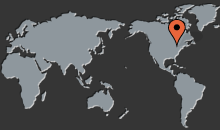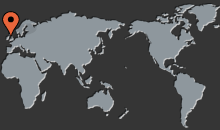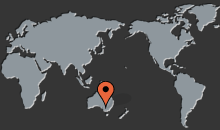MiniFAB Newsletter Edition #8, February 2012
Visit MiniFAB at MD&M West, Booth 828
MiniFAB's Chairman, Michael Wilkinson, and Manufacturing Manager, Bas Garst, will be in Anaheim this week to attend the Medical Design & Manufacturing West Conference. This show brings together companies working in all aspects of medical device development, including medtech professionals, OEM suppliers, etc. MiniFAB is interested to learn more about what other companies in the field are doing, and to present our capabilities in the development and manufacturing of medical devices.
Come and say hello to Michael or Bas at Booth 828, Anaheim Convention Center, February 14-16, 2012.

CEO Report
In late January I attended a great meeting organised by Micronarc and MANCEF in the Swiss Alps. A small and well focused meeting that allowed for good interaction, the collection of speakers provided a valuable snapshot of where the microfabrication industry is at the moment. Benedetto Vigna told us that thanks to Steve Jobs' efforts in building a huge market for smart phones, STMicroelectronics now manufactures over 3 million MEMS pieces per day (accelerometers, gyroscopes, microphones, compasses, etc.). Yet even still the accumulated global production of MEMS devices (approx. 1.8 billion) would fit into a cube 3.5m3 on a side. Would this be the world's most expensive cube?
MiniFAB gave a talk about the leading edge of polymer microfabrication, with our exceptional tolerances held on the high volume manufacture of the TearLab® nano-litre diagnostic device illustrating the precision and repeatability obtainable by injection moulding and laminate sealing. Interesting to see the update on injection moulding of ceramics from Dr. Volker Poitter. Moulding processes continue to challenge fabrication of the mould tooling itself, especially in robust steels. Therefore I was particularly interested to hear from Prof. Dr. Holger Reinecke and Dr. Thomas Gietzelt about how mechanical and electrodischarge machining continue their relentless drive down in size and tolerance. There were so many other interesting updates dealing with precision assembly, micro-robotics, printing technologies and test equipment. Then to finish a look into the future provided by Dr. Frank Stietz, MD of Carl Zeiss Nano Technology Systems. Machines moving towards 1nm patterning, multiple-beam writing, the world's first helium ion microscope and combination FIB / SEM tools. If ever a young researcher wanted to get on board the exciting times for "top-down" nanofabrication now is the time. Watch this meeting in coming years – the speakers are absolutely leaders of their industry.
Erol Harvey - CEO

TearLab's Regulatory successes
Late last year the TearLab Osmalarity test overcame two key regulatory hurdles that should see the adoption of the test greatly increase.
In Early December TearLab announced that they had received communication from the Food and Drug Administration (FDA) in the US indicating that the Agency had approved its petition for a waiver under CLIA for their Osmalarity System.
The good news kept coming when a week later the Centers for Medicare and Medicaid Services (CMS) publishing instructions for the reimbursement rate of the TearLab Osmalarity test to be revised to $23.25 per eye, across all US States. "With both the CLIA Waiver and uneven reimbursement obstacles now overcome, we can look forward to the adoption curve of this groundbreaking test steeping significantly in 2012," said TearLab's CEO, Elias Vamvakas.
MiniFAB currently manufactures 70,000 nanofluidic test cards per month for TearLab. "This is great news for TearLab. Having both the CLIA waiver and even reimbursement will allow many more people to use the diagnostic system, and we at MiniFAB are looking forward to ramping up our production to meet the increase in demand," said MiniFAB's Manufacturing Manager, Bas Garst.
The TearLab Osmolarity test diagnoses Dry Eye Disease, a condition that affects approximately 100 million people worldwide.

Update on the Bionic Eye
Researchers from the Monash Vision Group (MVG) are confident that they will have a bionic eye implant ready for patient tests in 2013
MVG and its partners (Monash University, The Alfred Hospital, Grey Innovation and MiniFAB) have been working on a ‘direct to brain' approach to restoring vision.
MVG's approach will see visual information captured by sensors and cameras and transmitted through a signal processor to microelectrode arrays implanted in the brain. The arrays will stimulate the visual cortex to produce phosphenes, or flashes of light, effectively creating bionic vision. By bypassing the optic nerve and retina, MVG's bionic eye will be suitable for up to 85 per cent of the blind community.
"We have made significant progress since beginning last year and are confident we will have a device that could treat the majority of patients who are clinically blind," said MVG Director, Professor Arthur Lowery.
Late last year a US provisional patent was filed on the surgical tool, developed by MiniFAB in collaboration with the Monash Physiology and Alfred Hospital clinical teams, that will be used to insert the microelectrode arrays into the visual cortex.
In November Luke Marsden, a Monash University Mechanical Engineering student who has been working on the design with MiniFAB as his final year project, presented a poster on the surgical tool at the Medical Bionics 2011 conference in Phillip Island.
In other Bionic Eye news, MiniFAB team members are close to finalising the design of the First In Human array, while production is underway on the first and second prototype arrays.
The MVG project is funded through an ARC Special Initiative in bionic vision science and technology.
To find out more about the Monash Vision Group project, see this recent article from ScienceAlert, or visit MVG's website.

For regular news and updates from MiniFAB, take a look at MiniFAB on Facebook or join MiniFAB on LinkedIn.




